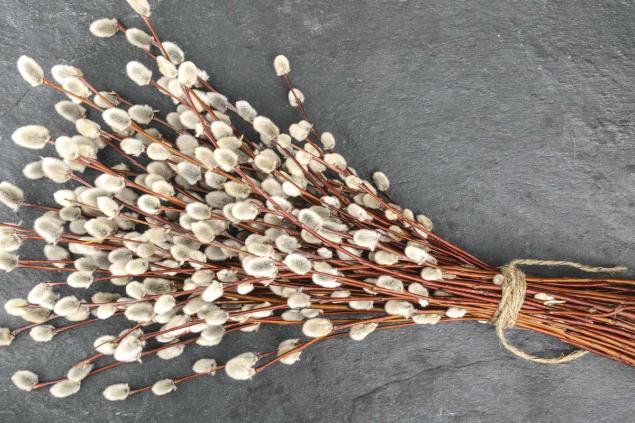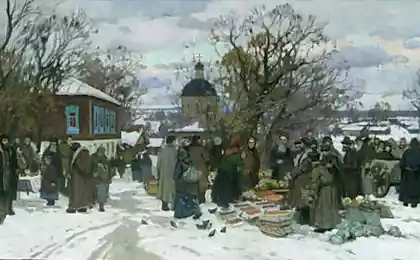148
What you need to do with the consecrated willow in order not to sin, do the right thing
The canons of the Church are not written anywhere. where to put last year's velvetIt doesn’t say you can’t throw it away. But consecrated twigs have always been treated with special reverence and honor, and it is still not customary to throw them in the trash.

In the old days, there was no question of where to put last year’s willow consecrated on Palm Sunday. In each house, behind the images, branches of willow were kept like amulets until the next Easter. They did not disturb anyone or cause inconvenience. During the year, they found special use. And when it came time to kindle the oven to prepare for the festival of kulichs, dry branches of willows were thrown into the fire.
The hostess believed that the consecrated branches of the willows, thrown into the oven, would contribute to making the cakes lush, ruddy and not cracked. When laying Easter dough in the form for baking, a small palm branch was stuck at the side of the side, so that the top of the kulich rose beautifully and did not move. Whether the hostess tried very hard, or the willow helped, but Easter pastries were always successful!

People sincerely believed in the divine power of the consecrated willow and used its branches throughout the year at any opportunity. Until next Palm Sunday, little remained of the old bouquet of willow. But no one threw away even the smallest rods. We should also adhere to this tradition.
What can be done with last year's slap? So that there is no doubt, where to put last year's willow, brought from the church bouquets put in a vase filled with water, and for a long time the branches are not stored. Then the willow is still fresh planted in the ground where it is convenient to grow.

If you have last year's dry willow, you'd better burn it. It will be convenient to do this during a foray into nature or a trip to the country when you want to make a fire to fry, for example, barbecue or sausages.
Previously, people resorted to the help of a consecrated willow. For example, after visiting the church on Palm Sunday, consecrated twigs jocularly whipped all family members to ensure good luck and good health.

Pregnant women wore pieces of consecrated willow as a talisman. And the childless put the willow in their pockets to get pregnant as soon as possible. Unmarried girls who wanted to get married hid a consecrated twig in their clothes in order to meet their betrothed as soon as possible.
Consecrated bouquets were kept in the house behind images to protect it from natural disasters and attract prosperity to the family. In ancient times, during a fire, a consecrated willow was thrown into the fire to put it out as soon as possible.

Twigs from Palm Sunday were planted at the corners of the field to protect the crop from pests and natural elements. A branch of willow brought from a church was planted near the house if there were adult children in the family, so that they would sooner marry or get married safely. It was considered a good sign when this faith took root and took root.
A consecrated branch of the willow was placed in the coffin during the funeral to protect the dead. They believed that faith would help their soul to enter heaven. When in the spring for the first time drove the cow to the pasture, they took a consecrated branch of the willow in their hands and escorted the animal to the herd. People believed that the willow would protect the nurse from the evil eye and spoilage, and there would always be plenty of milk in the house.

Follow traditions and do not throw away consecrated objects. Even if there is no strict prohibition of the church to take anything to the landfill, then, following the custom, it is not customary to do so with things sprinkled with holy water.

In the old days, there was no question of where to put last year’s willow consecrated on Palm Sunday. In each house, behind the images, branches of willow were kept like amulets until the next Easter. They did not disturb anyone or cause inconvenience. During the year, they found special use. And when it came time to kindle the oven to prepare for the festival of kulichs, dry branches of willows were thrown into the fire.
The hostess believed that the consecrated branches of the willows, thrown into the oven, would contribute to making the cakes lush, ruddy and not cracked. When laying Easter dough in the form for baking, a small palm branch was stuck at the side of the side, so that the top of the kulich rose beautifully and did not move. Whether the hostess tried very hard, or the willow helped, but Easter pastries were always successful!

People sincerely believed in the divine power of the consecrated willow and used its branches throughout the year at any opportunity. Until next Palm Sunday, little remained of the old bouquet of willow. But no one threw away even the smallest rods. We should also adhere to this tradition.
What can be done with last year's slap? So that there is no doubt, where to put last year's willow, brought from the church bouquets put in a vase filled with water, and for a long time the branches are not stored. Then the willow is still fresh planted in the ground where it is convenient to grow.

If you have last year's dry willow, you'd better burn it. It will be convenient to do this during a foray into nature or a trip to the country when you want to make a fire to fry, for example, barbecue or sausages.
Previously, people resorted to the help of a consecrated willow. For example, after visiting the church on Palm Sunday, consecrated twigs jocularly whipped all family members to ensure good luck and good health.

Pregnant women wore pieces of consecrated willow as a talisman. And the childless put the willow in their pockets to get pregnant as soon as possible. Unmarried girls who wanted to get married hid a consecrated twig in their clothes in order to meet their betrothed as soon as possible.
Consecrated bouquets were kept in the house behind images to protect it from natural disasters and attract prosperity to the family. In ancient times, during a fire, a consecrated willow was thrown into the fire to put it out as soon as possible.

Twigs from Palm Sunday were planted at the corners of the field to protect the crop from pests and natural elements. A branch of willow brought from a church was planted near the house if there were adult children in the family, so that they would sooner marry or get married safely. It was considered a good sign when this faith took root and took root.
A consecrated branch of the willow was placed in the coffin during the funeral to protect the dead. They believed that faith would help their soul to enter heaven. When in the spring for the first time drove the cow to the pasture, they took a consecrated branch of the willow in their hands and escorted the animal to the herd. People believed that the willow would protect the nurse from the evil eye and spoilage, and there would always be plenty of milk in the house.

Follow traditions and do not throw away consecrated objects. Even if there is no strict prohibition of the church to take anything to the landfill, then, following the custom, it is not customary to do so with things sprinkled with holy water.
What rings you need to wear to attract luck and wealth, small things matter
I asked my husband for new boots, but he said that there is no money for this, because it is so convenient to save on your wife, without denying yourself anything.






















